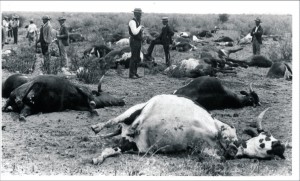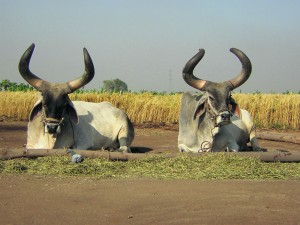SATURDAY, 29 JANUARY 2011
Perhaps you have never heard of rinderpest before. Unlike many of our pathogenic foes, such as AIDS, tuberculosis and cholera, rinderpest does not often hit the headlines, but this pathogen has had an astonishing influence on humankind, and a huge effort has been spent combating it. This year the eradication of rinderpest, or cattle plague as it is also known, will be officially declared making it only the second disease in history to be systematically eliminated by human intervention. Rinderpest has been a significant catalyst for the birth and development of modern veterinary science and its eradication is a monumental victory for the discipline.Rinderpest has haunted human civilisations for millennia, with the earliest historical reference dating back to around 3000 BC in Egypt. Domestic cattle, yaks and water buffalo are particularly susceptible to this virus, which severely damages its victim’s digestive system leaving the host weak and dehydrated. Due to the high mortality rate, famine often followed a rinderpest outbreak as people were dependent on their cattle for food, transport and skins.
Rinderpest has been a scourge throughout Asia, Africa and Europe, and has often been spread by trade and war. Notable pandemics were triggered across Europe by the invasions of the Hun and then Mongol armies in the 4th and 13th centuries. However, the pandemic of Africa in the 19th century probably represents the disease at its most destructive. The epidemic started in 1887 in Northeastern Africa. Rinderpest was brought to the continent by cattle imported from either Yemen or India to feed the Italian army based there. Over the subsequent ten years cattle plague tore through the continent killing 80-90 per cent of susceptible animals, both wild and domestic, a death toll that numbered millions. In 1893 the explorer Fredrick Lugard observed the scale of the rinderpest pandemic in Maasailand. He remarked: “Never before in the memory of man, or by the voice of tradition, have the cattle died in such numbers; never before has the wild game suffered.” A combination of smallpox and famine due to rinderpest brought about a huge reduction in the population of native Africans. This especially affected the Maasai people. The devastation in the Engaruka Basin in Tanzania led one Maasai man to exclaim that dead bodies were “so many and so close that the vultures had forgotten to fly.”
Despite its devastating history, rinderpest also has a positive legacy. Efforts to counteract cattle plague have inspired many developments in modern veterinary science. In the 18th century Giovanni Maria Lancisi, the physician of Pope Clement XI, was instructed to deal with a rinderpest outbreak that had killed over 26,000 papal cattle. Lancisi recognised that the plague ‘‘was caused by exceedingly fine and pernicious particles that pass from one body to another.’’ His solution was to control its spread by slaughtering ill and suspect animals, burying carcases in lime, controlling the movement of cattle and inspecting meat. The success of Lancisi’s method of controlling cattle plague led to the creation of the first veterinary school in Lyon. The school was established in 1762 and specialists were trained to combat threats such as rinderpest. Lancisi’s methods are still used today, for example to control the UK foot-and-mouth disease outbreak in 2001.
Strict control of animal movement during outbreaks was important for reducing the threat of rinderpest across Europe, but it was the development of vaccines that set the wheels in motion for removing the virus globally. An early vaccine developed in the late 1890s by Robert Koch involved immunising cattle with injections of bile from an infected animal. At the same time two South African scientists, Arnold Theiler and Herbert Watkins-Pitchford, worked on a more effective vaccine where cattle were injected with a mixture of infected blood and immune serum from a recovered animal. The passive immunity granted by injecting uninfected cattle with immune serum protected the host animals. At the same time their own immune system mounted a response against the virus in the infected blood, providing life-long immunity. Serum-simultaneous vaccination was used throughout India and Africa. This method was also independently developed and used to eradicate rinderpest in Western Russia by 1928. Further improvements in vaccination were achieved using attenuated viruses. These were developed by serially growing the rinderpest virus in live animals such as goats, rabbits or pigs that could propagate the virus but did not develop the disease.
Although early vaccines could be used to provide long-term immunity against rinderpest, there were drawbacks. One example is the inherent problem of transmitting other diseases in vaccines derived from live animals. In the late 1950s, Dr Walter Plowright developed a laboratory-grown attenuated virus that could be used as a vaccine. The Tissue Culture Rinderpest Vaccine (TCRV) was, for the first time, a safe method of providing life-long immunity after a single inoculation. However, one disadvantage was that the vaccine was inactivated at ambient temperatures, making it problematic to use in remote areas of developing countries. Improvements in virus growth conditions and freeze drying methods made it possible to generate a thermostable TCRV.
With vaccines in hand, the stage was set for the eradication of rinderpest. Vast countries such as China were able to banish the virus from within their borders using mass vaccination programmes. In the second half of the 20th century several international campaigns were able to reduce the global threat of the disease. Unfortunately, they ultimately failed to eradicate it completely and new epidemics repeatedly appeared. However, the creation of the Global Rinderpest Eradication Programme (GREP) in 1994, which coordinated vaccination and surveillance efforts, provided the momentum to finally eradicate cattle plague. An important key to GREP’s success was identifying hidden reservoirs of the virus that were repeatedly seeding new epidemics. These reservoirs were in isolated herds in countries like South Sudan where armed conflict made vaccination programmes particularly difficult. Ultimately it was the efforts of trained community animal health workers using TCRV that enabled the eradication of rinderpest from its last strongholds. In October 2010, GREP announced that it had successfully completed its objectives and had stopped field operations, paving the way for a declaration of global eradication of rinderpest.
The economic and humanitarian benefits of eradicating rinderpest have been astonishing. India alone is estimated to have benefited from $289 billion worth of additional agricultural production from 1965 to 1998 and it is believed Africa benefits from an extra $1 billion annually. The humanitarian benefit is difficult to quantify. However, considering that as recently as the 1980s nearly 100 million cattle were lost due to an African rinderpest pandemic, it is not an exaggeration to say that billions of domestic and wild animals have been saved. As a result of this the lives of millions of people must have been improved.
Dr Plowright was awarded the World Food Prize in 1999 in recognition of his contribution to eradicating rinderpest and the last recorded case of rinderpest was in Kenya in 2001. Like smallpox before it, the eradication of rinderpest stands as a testament to what can be achieved by international co-operation and science.
Paul Simpson is a postdoctoral researcher at the MRC Laboratory of Molecular Biology


